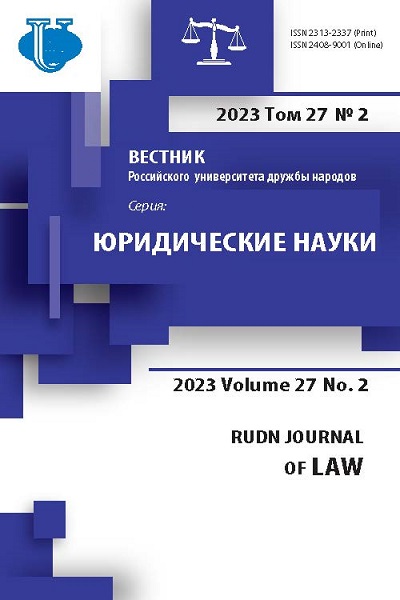The development of an insolvency privilegle for derivatives in German law
- Authors: Klementyev A.P.1
-
Affiliations:
- National Research University Higher School of Economics
- Issue: Vol 27, No 2 (2023)
- Pages: 453-467
- Section: CIVIL LAW
- URL: https://journals.rudn.ru/law/article/view/35035
- DOI: https://doi.org/10.22363/2313-2337-2023-27-2-453-467
- EDN: https://elibrary.ru/FVVPGP
- ID: 35035
Cite item
Full Text
Abstract
The article outlines the development of insolvency privilege with respect to derivatives under German law in its historical perspective. It traces the evolution of special privilege from the moment when it was first announced in the German insolvency statute (Insolvenzordnung) and came into force on August 1, 1994, up to the moment when legislative provisions securing the functioning of derivatives in insolvency context were amended in response to the 2016 Federal Court of Justice Verdict. This court ruling ended the long-standing consensus on “friendliness” of the German insolvency law to derivatives and other financial transactions. German highest court concluded that contractual clauses on the termination of obligations under derivative contracts in the event of bankruptcy are invalid unless their legal result is identical to the one prescribed by law. This court decision created significant legal uncertainty for recognition of claims under derivative transactions and directly influenced the use of standard master agreement for over-the-counter derivatives. Drafted under the auspices of the German Banking Union (GBU), an organization representing the interests of German financial institutions, German Master Agreement for Financial Derivatives Transactions ( Deutscher Rahmenvertrag fur Finanztermingeschäfte ) provided a contractual framework for the relevant market, and it came under significant pressure. Overall, German insolvency rules were significantly enforced to achieve the enforceability of close-out netting thus expanding the insolvency privilege for derivative transactions.
About the authors
Aleksey P. Klementyev
National Research University Higher School of Economics
Author for correspondence.
Email: aklementiev@hse.ru
ORCID iD: 0000-0002-6598-507X
ResearcherId: B-3826-2016
senior lecturer, School of Legal Regulation of Business
20 Myasnitskaya str., Moscow, 101000, Russian FederationReferences
- Benjamin, J. (2007) Financial law. Oxford, Oxford University Press.
- Benjamin, J. (2010) The narratives of financial law. Oxford journal of legal studies. 30(4), 787-814.
- Benzler, M. (1999) Nettingvereinbarungen im Auserborglichen derivatehandel. Baden-Baden, Nomos Verlagsgesellschaft. (in German).
- Böger, O. (2013) Close-out netting provisions in private international law and international insolvency law (Part I). Uniform Law Review. 18(2), 232-261. https://doi.org/10.1093/ulr/unt014.
- Böhm, M. (2001) Rechtliche Aspekte grenzüberschreitender Nettingvereinbarungen. Berlin, Duncker & Humblot. (in German).
- Fuchs, F. (2013) Close-out Netting, Collateral und systemisches Risiko: Rechtsansätze zur Minderung der systemgefahr im außerbörslichen derivatehandel. Berlin, Mohr Siebeck. (in German).
- Johnson, V.R. (2015). International financial law: the case against close-out netting. Boston university international law journal. 33(2), 101-125.
- Köbler, G. (2016) Juristisches Wörterbuch Für Studium und Ausbildung. Wahlen Jura, 16 Auflage. (in German).
- Lennon, A. (2001) Early termination payments under the 1992 ISDA Master Agreement. Journal of International Banking Law. 16(3), 84-92.
- Lober, K. & Klima, E. (2006) The implementation of Directive 2002/47 on financial collateral arrangements. Journal of international banking law and regulation. 21(4), 203-212.
- Lubben, S. (2010) Derivatives and bankruptcy: the flawed case for special treatment. University of Pennsylvania Journal of Business Law. (12), 61-78.
- Mantysaari, P. (1995) The Law of Corporate Finance: General Principles and EU Law: Vol. II: Contracts in General. Berlin, Springer.
- Molyneux, Ph., & Valdez, S. (2010) An Introduction to global financial markets. 6th ed. Palgrave Macmillan, Chippenham and Eastbourne.
- Paech, P. (2014) Close-Out Netting, Insolvency Law and Conflict-of-Laws. Journal of corporate law studies. 14(2), 419-452.
- Paech, P. (2016) The value of financial market insolvency safe harbors. Oxford journal of legal studies. 36(4), 855-884.
- Paul, C.R.H. (1995) Netting: a means of limiting credit exposure. Journal of international banking law. 10(3), 93-98.
- Paulus, C. (2015) The wonderful world of privileges - the par condicio creditorum vs closeout-netting. European company and financial law review. 11(4), 531-553. https://doi.org/10.1515/ecfr-2014-0531
- Rauch, S. (2017) Close-out netting fur finanzinstrumenten. Baden-Baden, Nomos. (in German).
- Reiner, G. (2002) Derivative finanzinstrumente im Recht. Baden-Baden, Nomos Verlagsgesellschaft. (in German).
- Rusen, G. (2007) Financial collateral arrangements. Journal of international commercial law and technology. 2(4), 250-258.
- Vardi, N. (2011) The integration of European financial markets. London, Routledge.
- Wessels, B. (1997) Close-out netting in the Netherlands. Journal of international banking law. 12(5), 187-194.
- Wood, Ph. (1995) Title financial, derivatives, securitizations and netting. Law and practice of international finance. London, Sweet and Maxwell.
- Yeowart, G. & Parsons, R. (2016) Yeowart and parsons on the law of financial collateral. Elgar Financial Law and Practice series. UK, Shepherd and Wedderburn LLP.
Supplementary files















